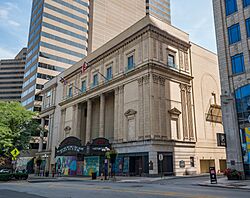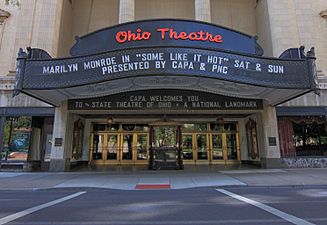Ohio Theatre (Columbus, Ohio) facts for kids

The Ohio Theatre in 2020
|
|
| Address | 39 E. State Street Columbus, Ohio United States |
|---|---|
| Public transit | |
| Owner | Columbus Association for the Performing Arts |
| Type | Movie palace |
| Capacity | 2,791 |
| Screens | 1 |
| Current use | live event venue |
| Opened | March 17, 1928 |
| Website | |
|
Ohio Theatre
|
|
| Architect | Thomas W. Lamb |
| Architectural style | Spanish baroque |
| MPS | Columbus MRA |
| NRHP reference No. | 73001437 |
| Significant dates | |
| Added to NRHP | May 5, 1977 |
| Designated NHL | May 5, 1977 |
The Ohio Theatre is a special place for shows and events in Downtown Columbus, Ohio. It's located right on Capitol Square. People even call it the "Official Theatre of the State of Ohio"! This amazing building opened way back in 1928. It used to be a fancy movie theater. In 1969, people worked hard to save it from being torn down. After that, it was completely fixed up and made beautiful again. In 1977, it was named a National Historic Landmark. This means it's a very important historical place.
The Ohio Theatre is owned and run by a group called CAPA. CAPA is a non-profit organization. They first formed in 1969 just to save the theater.
Contents
History of the Ohio Theatre
How the Ohio Theatre Began
The Ohio Theatre is in Downtown Columbus. It was built where the old Columbus City Hall used to be. A famous architect named Thomas W. Lamb designed it. He thought the Ohio Theatre was one of his best designs. He wanted people to feel like they were in a magical, luxurious place. This would help them forget their everyday worries.
A designer from New York, Anne Dornin, decorated the theater. Each room had its own special theme. Anne Dornin's favorite was the "Africa Corner." She filled it with real items from her travels. The theater also had fancy lounge areas for men and women. These even included separate rooms for smoking and making phone calls.
Opening as a Movie Palace
The theater was built by the Loew's movie chain with United Artists. It opened on March 17, 1928. It was a huge movie palace with 2,779 seats. The style was Spanish Baroque. The first movie shown was The Divine Woman, a silent film starring Greta Garbo.
The Ohio Theatre had its own orchestra. It also had a special Robert-Morton theater organ. This organ is still used today! Besides movies, the theater hosted amazing live shows. Famous performers like Fred Waring, Milton Berle, Ray Bolger, Buddy Ebsen, Ginger Rogers, Conrad Nagel, and Jack Benny performed there.
Changes Over Time
"Talking pictures" (movies with sound) came out in August 1928. People loved these new films. This meant theaters didn't need to have expensive live shows as much. So, regular stage shows stopped in 1933. The orchestra was also disbanded. However, the organist Roger Garrett kept playing the "Mighty Morton" organ every day. Sometimes, stars like Judy Garland and Jean Harlow still made special appearances.
The Ohio Theatre was the main place to see films from MGM and other studios. By the late 1930s, showing two movies for the price of one became normal. Movies usually played for one week. But huge hits like Gone with the Wind stayed for three weeks!
During World War II, movie theaters were very busy. The Ohio Theatre even added late-night showings for factory workers. War bonds were also sold in the lobby to help the war effort. In 1944, Roger Garrett joined the army. Live organ music then stopped for a while.
In the late 1940s, television became popular. Fewer people went to the movies every week. Also, many people moved from the city to the suburbs. This meant fewer customers for the theater. Profits went down, so the staff was smaller. Some seating areas were even closed off. Still, the Ohio kept showing popular films until it closed. The James Bond movies were very popular there in the 1960s. In 1966, a group called the American Theatre Organ Society started fixing the Robert Morton organ. They began playing it for shows again.
Saving the Ohio Theatre
Loew's closed the theater on February 24, 1969. The last movie shown was Play Dirty. A company bought the land. They planned to build an office tower where the Ohio and Grand Theatres stood. But the community stepped up! People worked hard to raise money. They wanted to buy the theater and keep it open. Some items from inside the theater were sold to help raise funds.
A non-profit group called the Columbus Association for the Performing Arts (CAPA) was formed. Architect Robert Karlsberger helped lead this effort. They raised money and made a plan for the theater's future. While they worked, live performances were held inside. This helped raise money and let people see the theater in action.
CAPA used the public's strong interest to get support from businesses and government leaders. In late 1969, enough money was raised to buy the Ohio Theatre. CAPA immediately started hosting shows and concerts. Rock musicians like The Grateful Dead, Frank Zappa, and Alice Cooper performed there. The Columbus Symphony Orchestra also needed a home. They started performing at the Ohio in the fall of 1969. Their ticket sales even went up because of the excitement about the new venue!
Restoration and Modernization
The building was fully restored to its original look throughout the 1970s. The Grand Theatre next door was torn down. Its space was first used for parking. In 1984, an addition was built there. It was called the Galbreath Pavilion. This pavilion was named after real estate developer John W. Galbreath and his wife Dorothy. It made the lobby bigger and added offices and rehearsal rooms.
The stage was also updated over time. This allowed for larger theatrical performances. They added a passage behind the stage, more dressing rooms, and a bigger orchestra pit. In the 1980s, the area around the theater was cleared for a shopping mall. CAPA got permission to make the stage even bigger. They doubled its size by expanding into the alley behind the theater. The theater also added more dressing rooms and a loading dock. This allows the Ohio to host big touring Broadway musicals.
The Ohio Theatre was one of the first movie palaces to be saved and used as a performing arts center. It became a great example for many other historical renovation projects in the United States. Unlike many other theaters from the 1920s, the Ohio still looks very much like it did when it first opened. Today, it is home to the Columbus Symphony Orchestra, BalletMet, the Broadway Series, Opera Columbus, and the CAPA Summer Movie Series.
Gallery
See also
- List of concert halls
- List of National Historic Landmarks in Ohio






